|
CONTACT: Media Interviews (415) 975-4382 (415) 975-4403 Internet address: http://www.bls.gov/ro9/news.htm Fax-On-Demand (415) 975-4567 - Code: #9710 |
BLS 04-36 |
CONSUMER EXPENDITURES IN THE WEST, 2001-2002
Consumer units1 in the West2 spent an average of $44,002 annually in 2001-2002, once again leading the nation in spending, according to the latest results from the Bureau of Labor Statistics' Consumer Expenditure Survey. Nancy Treadwell, acting regional commissioner in San Francisco, said that expenditures in the West region exceeded the national average by almost $4,000. Households in the West spent a larger than average portion of their budget on housing, but smaller shares on food and health care. A typical household in the West reported income of $51,003 before taxes, and was comprised of 2.6 persons and 1.4 wage earners. (See table 1.)
Chart 1. Percent distribution of total average expenditures, 2001-02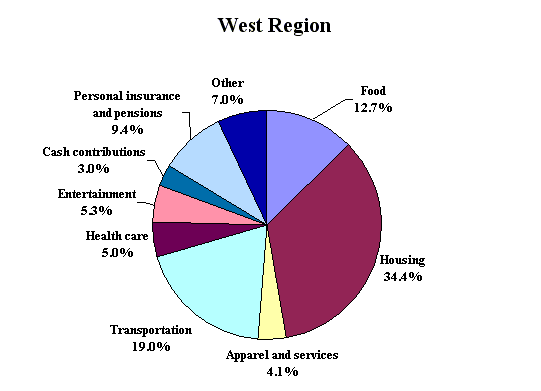
Expenditure shares in the West
Housing, the largest component of a household's expenditures, accounted for 34.4 percent of the budget in the West, up from 33.6 percent in 1999-2000. In comparison, housing accounted for 32.8 percent of a typical U.S. household's costs. Just over 63 percent of all spending on housing reflected expenditures for shelter, including expenses associated with owning, renting, and maintaining housing. Outlays for utilities, fuels and public services accounted for 16.5 percent of all housing costs. Sixty-one percent of all consumer units in the West were homeowners, lowest among the four regions of the country.
Transportation was the second largest component of total spending in the West, accounting for 19.0 percent of household expenditures in 2001-2002, similar to the national share of 19.2 percent. More than 45 percent of every transportation dollar was spent on purchasing a vehicle; over 16 percent was spent on gasoline and motor oil to operate vehicles. Public transit expenditures, which include buses, taxis, subways, trains and planes, accounted for the smallest share of a household's transportation costs in the West at 5.6 percent.
Among other expenditure categories, spending on food accounted for 12.7 percent of a household's budget, a bit below the national average. Payments for life and other personal insurance (except health) and contributions to pension plans and Social Security made up 9.4 percent of total spending, with the latter accounting for over nine-tenths of the cost. Entertainment accounted for 5.3 percent of a household's budget in the West; out-of-pocket spending on health care represented 5.0 percent of all expenditures and apparel, 4.1 percent.
1See Technical Note at the end of this release for definition of consumer unit. For convenience, the term consumer unit is used interchangeably with the term household.
2The West region is comprised of 13 states. A listing of states included in each of the four geographic regions of the country is contained in the Technical Note.
Expenditures across regions
Average annual expenditures for households in the four geographic regions of the country varied widely in 2001-2002 ranging from $36,788 in the South to $44,002 in the West. The share of total expenditures within each of the major categories varied as well, though housing accounted for the largest percentage in each region. Households in the Midwest and South typically spent a smaller share of total expenditures on housing (31.3 and 31.5 percent, respectively) than did their counterparts in the West and Northeast (34.4 and 34.7 percent, respectively). In addition, Midwesterners and Southerners were more likely to own their own home (70 and 68 percent, respectively) than were those in the West and Northeast (61 and 64 percent, respectively).
Transportation expenditures accounted for a larger share of total household spending in the South than in the other regions. Southerners allocated 20.2 percent of all household expenditures for transportation costs compared to 17.2 percent in the Northeast. Households in the Northeast, by contrast, spent the highest share on public transportation (and averaged the lowest number of vehicles per household at 1.7). Conversely, consumer units in the South spent a larger percentage of their budget on both vehicle purchases and motor fuels than did those households in other regions of the country, while those in the Northeast had the smallest share.
Among the other major expenditure categories, there was generally little variation on a regional basis. For example, differences between the four regions' expenditure shares on apparel and services was less than 1 percentage point, varying from 4.1 percent in the West to 4.8 percent in the Northeast. Similarly, expenditure shares for entertainment ranged from 4.6 percent in the South to 5.4 percent in the Midwest.
Additional Data Available
Consumer expenditure data for nine metropolitan areas in the West region are included in tables 3 and 4 of this release. National data are available in Consumer Expenditures in 2002 (Report 974), released February, 2004. Detailed tables are available online at http://www.bls.gov/cex. Further information or assistance can be obtained by contacting the San Francisco Information Office at 415-975-4350 between 9:00-11:30 a.m. and 1:30-4:00 p.m. pacific time.
The current Consumer Expenditure Survey (CE) program began in 1980. Its principal objective is to collect information on the buying habits of American consumers. The consumer expenditure data are used in wide varieties of research by government, business, labor, and academic analysts. The data are also required for periodic revision of the Consumer Price Index (CPI).
The survey consists of two components, a Diary or recordkeeping survey, and an Interview survey. The Diary survey, completed by participating consumer units for two consecutive 1-week periods, collects data on frequently purchased, smaller items. The Interview survey, in which the expenditures of consumer units are obtained in five interviews conducted every 3 months, collects data for larger-cost items and expenditures that occur on a regular basis. The U.S. Census Bureau collects the survey data.
Each component of the survey queries an independent sample of consumer units which is representative of the U.S. population. Over the year, about 7,500 consumer units are sampled for the Diary survey. The Interview sample is conducted on a rotating panel basis, with about 7,500 consumer units participating each quarter. The data are collected on an ongoing basis in 105 areas across the four regions of the country.
The integrated data from the BLS Diary and Interview surveys provide a complete accounting of consumer expenditures and income, which neither survey component alone is designed to do. Due to changes in the survey sample frame, area data in this release are not directly comparable to those prior to 1996-97.
The expenditure data in this release should be interpreted with care. The expenditures are averages for consumer units with the specified characteristics, regardless of whether a particular unit incurred an expense for a specific item during the recording period. The average expenditure may be considerably lower than the expenditure by those consumer units that purchased the item. This study is not intended as a comparative cost of living survey as neither the quantity nor the quality of goods and services has been held constant among the areas. Expenditure levels vary among areas not only because of economic factors such as the price of goods and services and family income, but also because of differences such as the age of the population, climate, consumer tastes, family size, etc. However, a comparison of expenditure shares (or the percentage of a consumer unit's budget spent on a particular item) is acceptable. Lastly, users should keep in mind that prices for many goods and services have risen since the survey was conducted.
In addition, sample surveys are subject to two types of errors. Sampling errors occur because the data are collected from a representative sample rather than the entire population. Nonsampling errors result from the inability or unwillingness of respondents to provide correct information, differences in interviewer ability, mistakes in recording or coding, or other processing errors. The year-to-year changes are volatile and should be interpreted carefully. The sample survey for the nation is much larger than for individual metropolitan areas, meaning the resulting national estimates are more reliable than those for the metropolitan areas.
Some expenditure components are subject to large fluctuations from one year to the next because these components include expensive items that relatively few consumers purchase each year. Thus, shifts from year to year in the number of consumers making such purchases can have a large effect on average expenditures. Examples of these types of expenses are purchases of new cars and trucks in the transportation component, and spending on boats and recreational vehicles in the entertainment component.
The Consumer Expenditure Survey presents data for the four geographic regions of the country-- Northeast, South, Midwest, and West--as defined by the U. S. Census Bureau. The states comprising these regions are listed below.
The Northeast: Connecticut, Maine, Massachusetts, New Hampshire, New York, New Jersey, Pennsylvania, Rhode Island, and Vermont.
The Midwest: Illinois, Indiana, Iowa, Kansas, Michigan, Minnesota, Missouri, Nebraska, North Dakota, Ohio, South Dakota, and Wisconsin.
The South: Alabama, Arkansas, Delaware, Florida, Georgia, Kentucky, Louisiana, Maryland, Mississippi, North Carolina, Oklahoma, South Carolina, Tennessee, Texas, Virginia, West Virginia, and the District of Columbia.
The West: Alaska, Arizona, California, Colorado, Hawaii, Idaho, Montana, Nevada, New Mexico, Oregon, Utah, Washington, and Wyoming.
Definitions
Consumer unit - a single person living alone or sharing a household with others but who is financially independent; members of a household related by blood, marriage, adoption, or other legal arrangement; or two or more persons living together who share responsibility for at least 2 out of 3 major types of expenses - food, housing, and other expenses. The terms household or consumer unit are used interchangeably for convenience.
Complete income reporter - in general, a consumer unit that provides values for at least one of the major sources of its income such as wages and salaries, self-employment income, or Social Security income. Even complete income reporters may not have provided a full accounting of all income from all sources.
Expenditures - consist of the transaction costs, including excise and sales taxes, of goods and services acquired during the interview or recordkeeping period. Expenditure estimates include expenditures for gifts, but exclude purchases or portions of purchases directly assignable to business purposes. Also excluded are periodic credit or installment payments on goods or services already acquired. The full cost of each purchase is recorded even though full payment may not have been made at the date of purchase.
Income before taxes - the total money earnings and selected money receipts during the 12 months prior to the interview date.
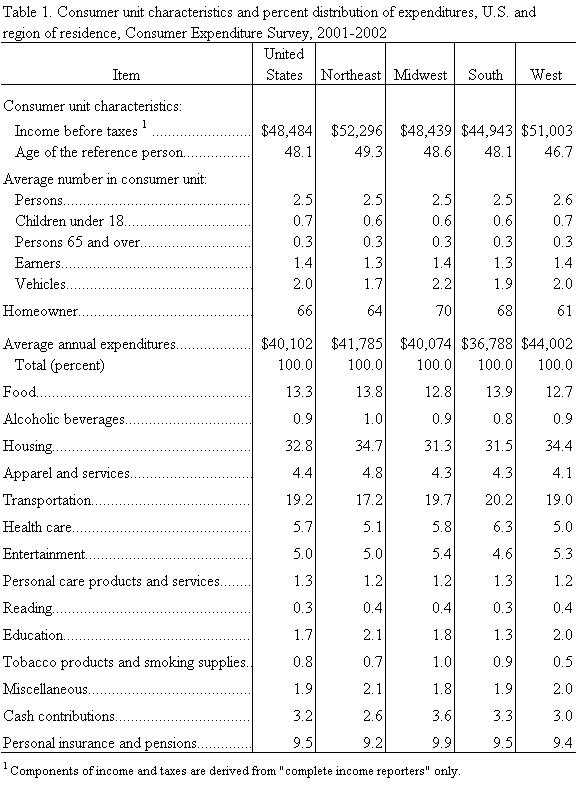
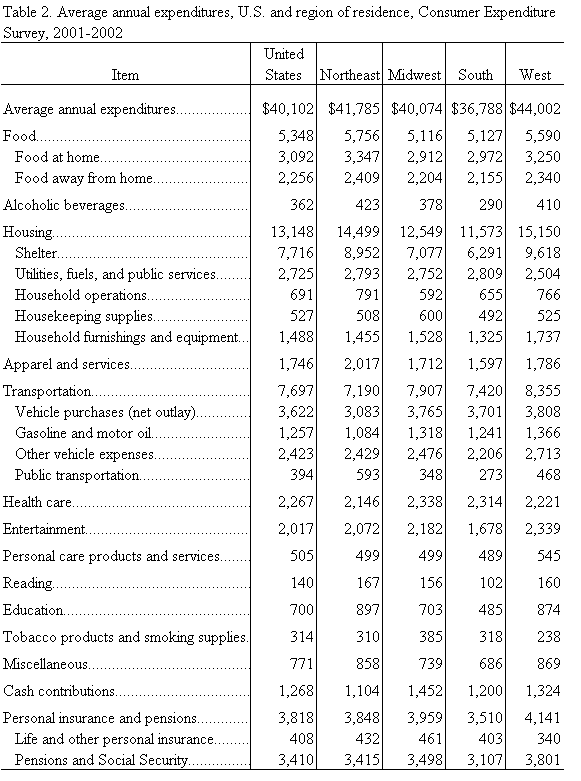
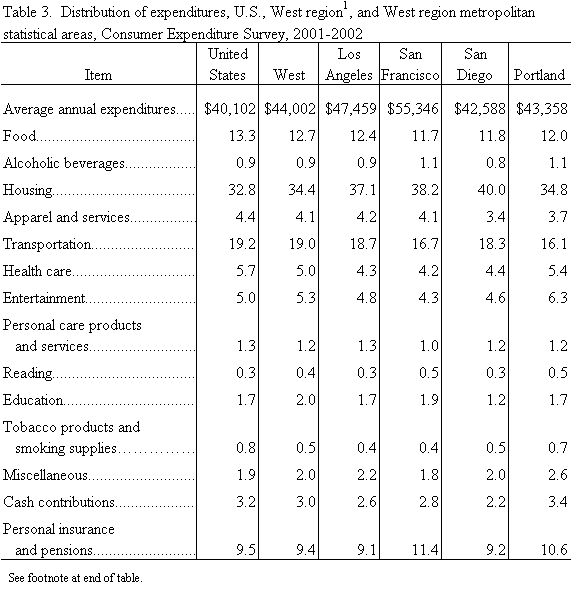
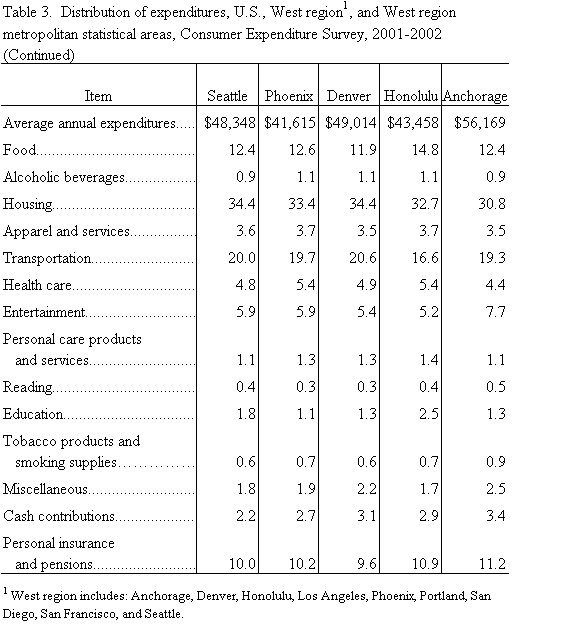
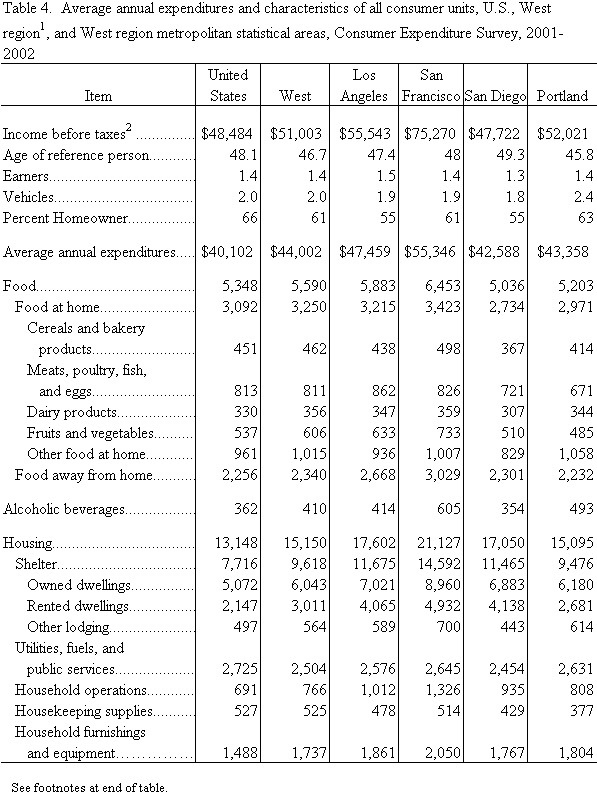
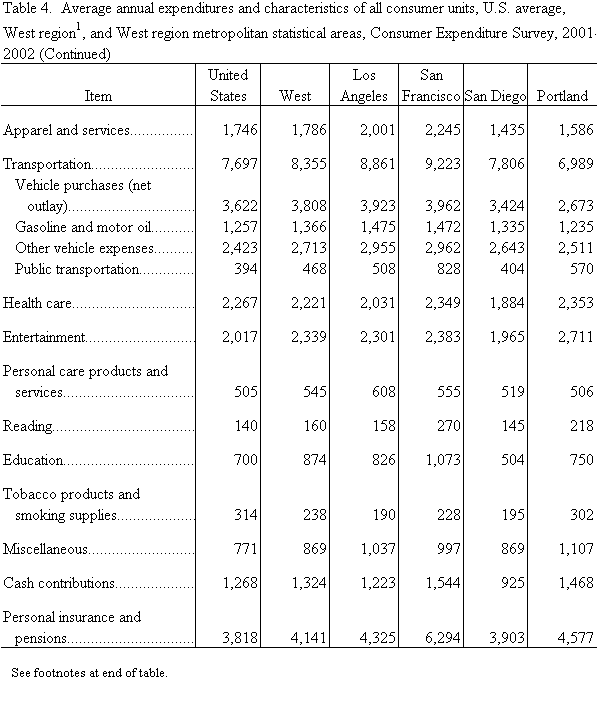
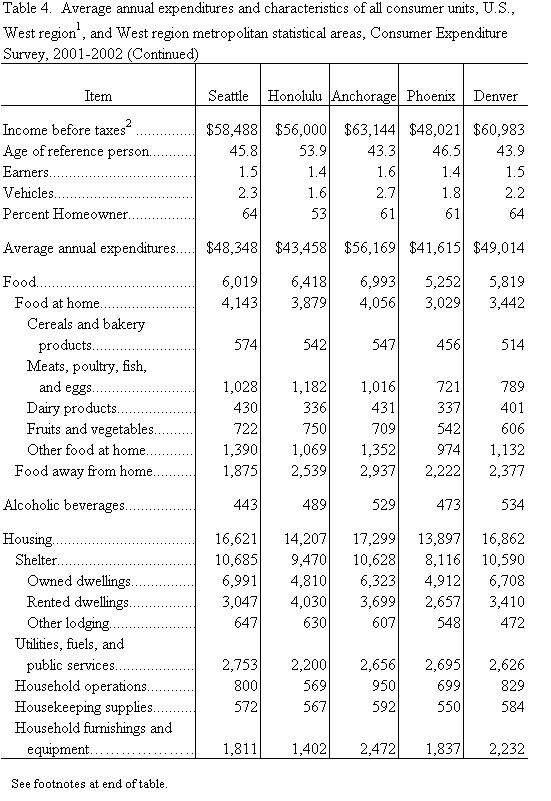
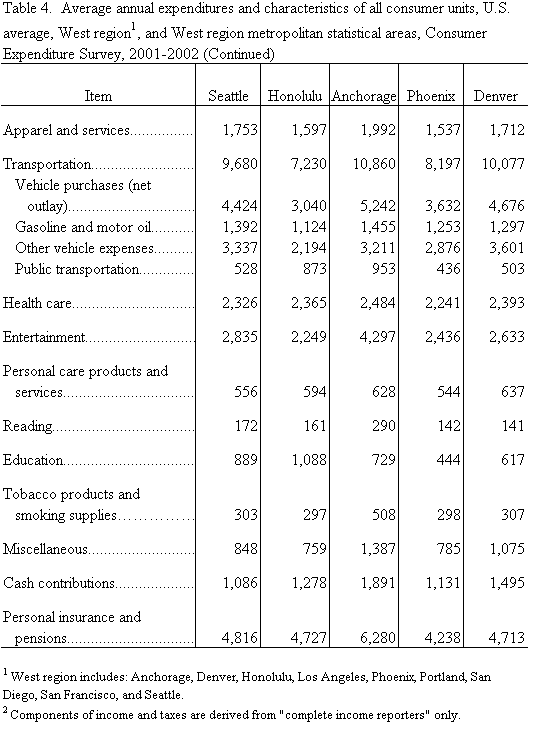
Last Modified Date: October 14, 2004

